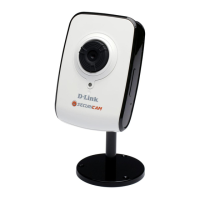
Do you have a question about the D-Link DCS-910 and is the answer not in the manual?
| Camera Type | IP Camera |
|---|---|
| Image Sensor | 1/4" CMOS |
| Resolution | 640 x 480 |
| Power over Ethernet | No |
| Connectivity | Wired |
| IP Camera | Yes |
| Video Compression | MJPEG |
| Network Interface | 10/100Base-T Ethernet |
| Power Supply | 5V DC |
| Operating Temperature | 0°C to 40°C |
| Operating Humidity | 20% to 80% non-condensing |
Lists all items included in the DCS-910 Internet Camera package.
Specifies the minimum hardware and software needed to use the DCS-910 camera.
Details the components and indicators on the front of the DCS-910 camera.
Details the connectors and buttons on the rear of the DCS-910 camera.
Instructions for securely attaching the camera's swivel stand.
Steps to connect the DCS-910 camera to the network using an Ethernet cable.
Instructions for connecting the power adapter to the DCS-910 camera.
Guide to installing the DCS-910 software using the Click 'n Connect utility.
Instructions for installing the alternative Setup Wizard software.
Step-by-step guide to configuring the DCS-910 camera using the Setup Wizard SE.
How to access and view the camera's live video feed through a web browser.
Viewing video streams using ActiveX for Windows users without Java.
Viewing video streams using Java for Windows and Mac users.
Configuring the camera's network settings using the Setup Wizard.
Configuring LAN settings: DHCP, Static IP, or PPPoE.
Setting up Dynamic DNS for remote access to the camera.
Assigning a descriptive name to the camera for easy identification.
Setting the correct time zone for accurate event logging.
Using DHCP for automatic IP address assignment by the network.
Manually assigning a static IP address to the camera.
Configuring PPPoE for direct internet connection via DSL modem.
Configuring a secondary HTTP port for camera access.
Enabling UPnP for automatic network device configuration.
Configuring DDNS to access the camera using a domain name.
Adjusting image parameters like brightness, contrast, and saturation.
Setting video quality, resolution, and frame rate for the camera.
Setting up email accounts for receiving camera notification alerts.
Configuring the schedule for sending email snapshots.
Configuring an FTP server to receive images from the camera.
Scheduling when image uploads to the FTP server should occur.
Selecting the appropriate time zone for the camera's region.
Synchronizing camera time with an Internet Network Time Protocol server.
Synchronizing the camera's time settings with the connected computer.
Changing or managing the administrator password for the camera.
Configuring camera name and LED control options.
Adding, modifying, or deleting user accounts for camera access.
Saving the current camera configuration settings to the local hard drive.
Restoring camera configuration settings from a saved file.
Resetting the camera's settings to their original factory defaults.
Restarting the DCS-910 camera.
Displays the current firmware version and date of the camera.
Step-by-step instructions for upgrading the camera's firmware.
Displays detailed information about the camera's device and network settings.
Initiates the D-ViewCam software installation process.
Choosing the preferred language for the D-ViewCam installation.
Steps to start the D-ViewCam application.
Logging into the D-ViewCam system with user credentials.
Introduction to the wizard for adding cameras to D-ViewCam.
Guidance on navigating through the steps of the Add Camera Wizard.
Choosing between Auto Discovery or manual IP address entry for adding cameras.
Configuring 24/7 continuous recording for a camera.
Setting up recording that is triggered by motion detection.
Configuring recording to occur only during specified office hours.
Configuring recording to occur only outside specified office hours.
Option to add additional cameras after initial setup.
Lists the necessary hardware and components for setup.
Overview of the process for setting up the camera behind a network router.
Steps to assign a local IP address using the setup wizard.
Accessing camera settings and network configuration via Internet Explorer.
How to access the router's administrative settings through a web browser.
Enabling virtual server settings to allow remote access to the camera.
Troubleshooting why the power LED may not be consistently lit.
Troubleshooting why the LAN LED may not be functioning correctly.
Diagnosing problems with local access but not remote access.
Addressing image distortion caused by sensor overload from bright lights.
Solutions for video images appearing noisy, especially in low light.
Tips for enhancing image quality by adjusting camera settings.
Troubleshooting why no images are visible when accessing via web browser.
Steps to verify the IP address assigned to your network adapter.
Manually configuring a static IP address for your network adapter.